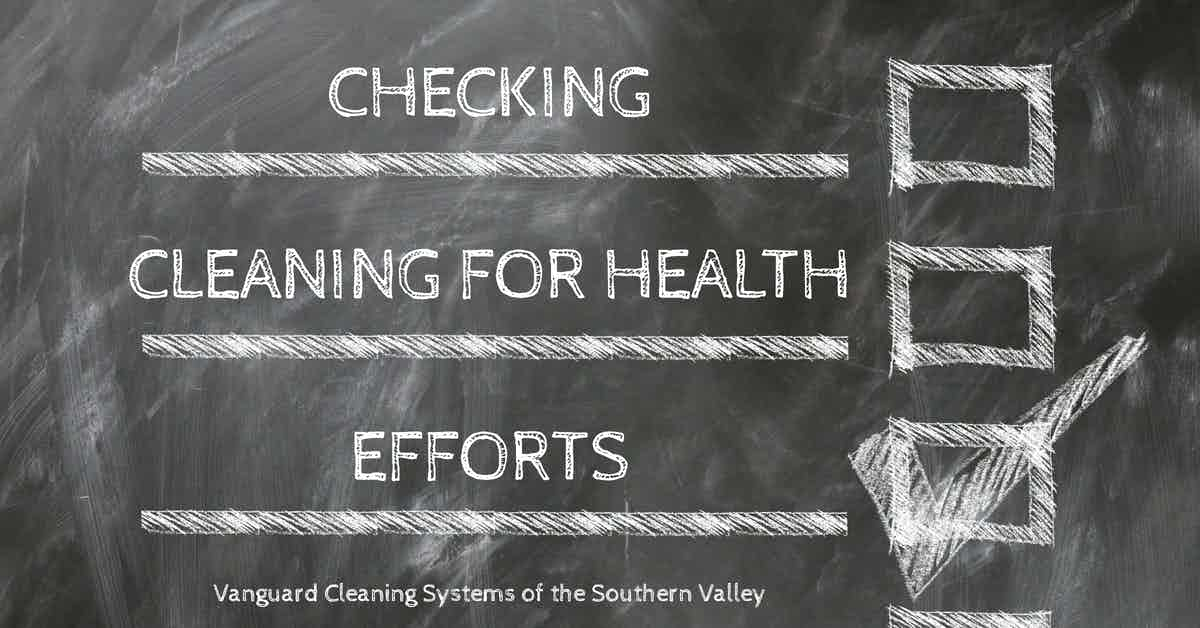As organizations across the state begin to ramp up for full-scale reopenings, facility sanitation procedures--much of which is presently focused on touchpoint sanitization to fight off COVID--must be refocused on cleaning for health best practices that prioritize occupant wellness and facility safety.

How Good Are Your Cleaning For Health Procedures?
As the unrest surrounding the SARS-CoV-2 pandemic subsides, schools and businesses are advised to assess current infection prevention methods and make necessary adjustments to ensure a renewed focus on cleaning for health and occupant safety.
Three areas commonly neglected yet representing potentially serious health and safety issues include:
- Floorcare and safety.
- Disinfectant use and management, and;
- Solution monitoring.
How SaFe Are The Floors?
Facility flooring is commonly neglected, yet represents a major route for the introduction of allergens, pathogens, fungi, dust, soil, dangerous chemicals, and bacteria.
Further, poorly maintained flooring presents significant slip, trip, and fall hazards--a leading cause of non-fatal accidents and injuries in the workplace.
Floor safety can be negatively impacted by:
- Dust
- Icy weather conditions, and;
- Water on the floor from weather, leaks, or mopping.
Floors, especially those in high-traffic facilities, should be swept, dusted, and mopped every day the facility is occupied, followed by manufacturer-recommended deep cleaning maintenance cycles.
Further, over time, the floor's slip resistance will decline due to maintenance, foot traffic, and weather conditions, and therefore should be routinely tested to verify occupant safety.
Are You Using Disinfectants Safely?
It is no secret that disinfectants are commonly misused, often with dangerous results.
During the course of the pandemic, many individuals admitted to a wide range of ill-advised practices that included applying disinfectant products to their skin and food, with some admitting to going so far as to drink or gargle bleach.
Others admitted to a dangerous lack of knowledge regarding bleach dilution requirements or what chemicals should never be mixed with bleach or combined with other commercial disinfectants.
Among the more common issues plaguing commercial buildings regarding disinfectant applications are over or under dilution, which can result in low-quality cleaning outcomes or over-exposure to corrosive chemicals.
Over-diluting a disinfectant means it doesn’t work as well. It makes sense: if you dilute your disinfectant too much, the potency of the disinfectant suffers and it won’t be strong enough to kill pathogens as effectively.
It also raises the possibility that the organisms exposed to this low-potency disinfectant can develop resistances over time from these low levels of exposure, making them even harder to eliminate.
However, not diluting a disinfectant enough has a whole host of other problems; concentrated disinfectants are often toxic before dilution.
This means that using a disinfectant that hasn’t been diluted enough can be harmful to your health, harmful to the health of animals, and even harmful to the environment!
How Inaccurate Dilution Affects the Efficacy of Disinfectants
Methods commonly employed to address over or under dilution challenges include:
- Chemical management systems, which automatically dilute and pour chemicals into a bucket, or;
- Pre-packaged--think detergent pods--solutions that are placed into a bucket of water containing a designated volume of water.
Are You Changing Out Your Cleaning Solution Often Enough?
Cleaning surfaces with dirty, contaminated water will lead to cross-contamination, undesirable cleaning outcomes, occupant illness, and decreases in productivity.
However, dumping out a bucket too soon will increase resource waste, time to task completion, and associated costs.
Unfortunately, there is no one-size-fits-all answer.
Solution contamination is often a byproduct of several factors, including how much soil is present on the surface that is being cleaned.
Therefore;
Common sense needs to be applied when determining when the mop water should be changed.
Because different soil loads will be present on various floor types and in various locations, the water may become heavily soiled at different intervals in the mopping process.
In addition to this, there are different sizes of mop buckets so the solution will become heavily soiled at different times depending on the volume of the bucket being used.
So one can’t just say the water should be changed after cleaning “x amount” of square feet.
Basically, the water is as dirty as it looks and that is what is being spread on the floor.
The frequency with which one changes the mop water is dependent on the above-mentioned factors so it can be different in each situation, but to put it simply the water should be changed when it becomes obviously stained by soiling.
One way to reduce solution contamination, maximize resource utilization, and prevent cross-contamination is through the two-bucket cleaning method, whereby the solution is kept in one bucket, and dirty water where the rag or mop is wrung out is kept in another.
Takeaway
Refocusing facility cleaning efforts on occupant health will help ensure a smooth transition to full-time workplace occupation, ease workforce and consumer anxiety, and help manage costs.
Skilled and trained technicians are required to maintain the standards necessary to achieve consistent high-level clean for health outcomes.
Outsourcing is a proven method for onboarding highly in-demand cleaning and sanitization services and experience for a fraction of the price of maintaining a similar service in-house.
If you would like more information regarding the effectiveness of high-performance infection prevention and control measures, or if you would like to schedule a free, no-obligation on-site assessment of your facility's custodial needs, contact us today for a free quote!
In Bakersfield, CA, call (661) 437-3253
In Fresno, CA, call (559) 206-1059
In Valencia, CA, or Santa Clarita, CA, call (661) 437-3253
In Palmdale, CA or Lancaster, CA, call (661) 371-4756

